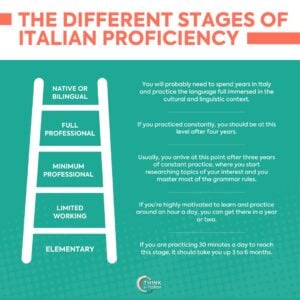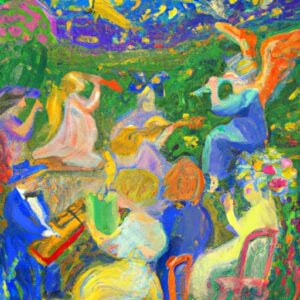What is the past participle?
The Italian past participle is the equivalent of played, cleaned, done, gone, seen, etc.
Below are some examples:
Ho appena visto tuo fratello.
I have just seen your brother.
However, it doesn’t always translate like that, as you can see here:
La scorsa settimana siamo andati a teatro.
Last week we went to the theater.
If you’re learning Italian, you probably already encountered the Italian past participle many times but didn’t realize it, unless you were already familiar with it.
When we talk about the past in Italian, we use it all the time.
How to use the past participle?
The past participle needs to go together with one of the two Italian auxiliary verbs: essere or avere.
Have a look at the examples below to understand better:
Ho mangiato troppo.
I have eaten too much.
Sono stata in Italia.
I have been to Italy.
We couldn’t have said mangiato troppo or stata in Italia on their own because it would have looked incomplete.
It’s the same in English. Would you say I eaten too much or I been to Italy? No, because on its own, the past participle doesn’t make much sense.
For this reason, it is considered an unfinished verb mode, which means it doesn’t give us much information about the person who did the action.
How to form the past participle of regular verbs?
The past participles of regular verbs are formed as follows:
- Past participles of -are verbs end in -ato
- Past participles of -ere verbs end in -uto
- Past participles of -ire verbs end in -ito
Let’s take a look at some examples:
Verbs ending in -are
- Ballare (to dance): ballato
- Camminare (to walk): camminato
- Lavorare (to work): lavorato
- Mangiare (to eat): mangiato
Verbs ending in -ere
- Avere (to have): avuto
- Cadere (to fall): caduto
- Credere (to believe): creduto
- Sapere (to know): saputo
Verbs ending in -ire
- Capire (to understand): capito
- Dormire (to sleep): dormito
- Finire (to finish): finito
- Sentire (to feel): sentito
How to form the past participle of irregular verbs?
Some verbs have irregular past participles. In this case, you just need to memorize them.
You could write them down or make up a game to practice them.
Here are some of them:
- Aprire (to open): aperto
- Essere (to be): stato
- Conoscere (to know or meet): conosciuto
- Fare(to do): fatto
- Dire (to say): detto
- Chiedere (to ask): chiesto
- Leggere (to read): letto
- Mettere (to put): messo
- Perdere (to lose): perso
- Rompere (to break): rotto
- Ridere (to laugh): riso
- Scrivere (to write): scritto
- Vedere (to see): visto
- Venire (to come): venuto
- Vivere (to live): vissuto
How to use verb tenses formed with the past participle?
As we already mentioned, the past participle goes together with the conjugated form of either avere or essere in this order: Corresponding conjugated form of avere or essere + past participle
The verb tenses that are formed with the past participle are the following:
- Passato prossimo (present perfect)
Construction: present tense of avere or essere + past participle
Cosa hai fatto?
What have you done?
- Trapassato prossimo (past perfect)
Construction: imperfect tense of avere or essere + past participle
Non ero mai stata in Italia.
I had never been to Italy.
- Condizionale passato (past conditional)
Construction: present conditional tense of avere or essere + past participle
Mi sarebbe piaciuto fare più foto, ma purtroppo avevo il cellulare scarico.
I would have liked to take more pictures, but unfortunately, my mobile phone was out of battery.
- Congiuntivo passato (past subjunctive)
Construction: present subjunctive tense of avere or essere + past participle
Non credo che Mario mi abbia detto la verità.
I don’t think Mario told me the truth.
- Congiuntivo trapassato(past perfect subjunctive)
Construction: imperfect subjunctive tense of avere or essere + past participle
Avevo paura che non avessero risolto quel problema.
I was afraid they hadn’t solved that problem.
The past participle: essere or avere?
You might wonder when we use essere and when we use avere. All foreigners learning Italian ask themselves the same question. And here’s the answer:
- We use avere with most Italian verbs such as mangiare (to eat), ballare (to dance), and dormire (to sleep).
- We use essere with the following verbs:
- Movement verbs (andare: to go, venire: to come)
- Reflexive verbs (svegliarsi: to wake up, lavarsi: to wash oneself)
- Verbs that indicate the state of something or someone (essere: to be, stare: to be or feel)
When we use the past infinitive with the verb essere, the past participle agrees in number and gender with the noun it refers to, like in the example below:
Sono andati a casa presto.
They went home early.
As you can see, we said tornati and not tornato or tornate since we’re referring to they.
Practice with Quizlet
Here's a set of flashcards and quizzes to practice this grammar topic.Are there other uses of the past participle?
Past participles are not only used in verbal constructions but also for other purposes.
They can be used as nouns, like in the example below:
Entrare nell’appartamento di uno sconosciuto è un reato.
Getting into a stranger’s apartment is a crime.
In this example, sconosciuto is the past participle of sconoscere (to not know).
They can also be used as adjectives:
Ha comprato una macchina rubata.
He bought a stolen car.
Here, rubato, the past participle of rubare (to steal).
However, these uses of the Italian past participle are not very common.



















